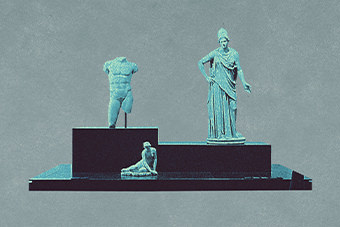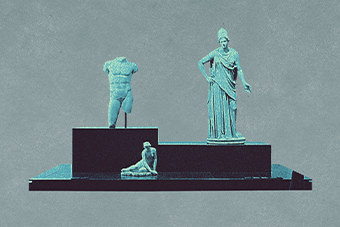Vaacha is a tribal museum placed in the heartland of the Rathwa tribe, a sub-group of the Bhils. It is part of the Adivasi Academy founded by the Bhasha Research and Publication Centre in 1998. It has been named ‘Vaacha’ as a metaphor for the unheard adivasi voice. The Rathwa lands border Madhya Pradesh to the east and Rajasthan to the north-west, thus it speaks of the thriving cultural diaspora of the Adivasi land expanding from west to central India. The Museum speaks of time and space layered in different strata of history. Evidence of 12,000 BC rock paintings and remnants of the medieval period Tejgadh fort are present in its vicinity at half a kilometre distance from the Academy. This is how the Museum blends with its surroundings, representing the socio-cultural identity of the place.
The sense of belonging and identity is at the core of the Museum’s ideology as its curators, collectors, documenters and conservationists are from the same land and community. From its foundation, it has resolved not to imitate other ethnographic museums in subject or design. Thus, Vaacha Museum resolved to have open walls fusing with the surrounding landscape and merging with the resources of the Adivasi Academy such as its library, Bhasha Van, Lakhara artist studio, Vasantshala school, traditional medicine garden, workshop space, etc. The Museum stands as an ideal example of a contextual space of learning from the adivasi culture.
Museums are active agents of the revitalisation, representation and expressions of cultures, and Vaacha has taken many initiatives in this direction. In its annual programme, the Tur Tribal Music Festival is an important event where people from different adivasi communities are invited to perform, not on ‘stage’ but in open spaces across the 10 acres of the Academy premises in natural surroundings. Vaacha Museum and the Adivasi Academy complex is designed in tune with the mud houses of the adivasis in the vicinity, made with environmentally friendly red exposed bricks. It blends well with the surrounding earthy colours. The Academy complex was by the renowned Vadodara-based architect Karan Grover.
Additional information
The Museum also includes visits to the Bhasha Van and the Documentation Centre. Bhasha Van is an audio-visual guide that walks through the trees which represent more than 100 Indian languages. The Documentation Centre has digitised collections of musical and performative traditions of adivasis across the country and also houses the archive of the Consortium of Museums Project. If one has enough time, then a visit to these two is also recommended.
Tur Music Festival and craft workshops are organised regularly. There is no standard calendar for it as these events are dependent on availability of funds. Prior announcements are made on the website and Bhasha’s social media page from where one can get updates.
Acquisition Policy
Acquisition of artefacts is a regular feature of the Vaacha Museum. Various workshops are organised for the revival of traditional crafts and their documentation. This leads to regular acquisition of artefacts from tribal communities. Also, some of the articles made of terracotta and wood displaced in open spaces require replacement due to withering. This helps in regular commissioning of the tribal artisans. The Museum also has a shop for which craft objects are acquired regularly.
The Adivasi Academy has a residential primary school for children from migrant tribal families called Vasantshala. The Museum is open to these children 24 hours with freedom to take out any musical instrument of their choice to play. Sometimes, this leads to damage, in which case they are repaired. This established Vaacha as a museum of living culture rather than a museum of antiquity.
Display Policy
The curators, the caretaker, cleaners and restorers are all from the tribal community of the region. Thus, the display of the Museum is left to their choice. It keeps changing with the seasons as the direction of light keeps changing (the Museum does not use artificial spotlights). Certain delicate objects which are in glass showcases remain permanently displayed, while the rest are relocated according to requirements. This happens twice a year.
More Information
Getting there
Road: Adivasi Academy is 90 kms from Vadodara city in Gujarat. Regular state government buses run from Vadodara Bus stand going to Chhota Udepur/Alirajpur. It takes around three hours to reach Tejgadh.
Rail: One can take a train from Pratapgarh station (in Vadodara) to Tejgadh. From Tejgadh Railway station Adivasi Academy is at a distance of 1 km.
Air: Nearest airport is Vadodara, from where a taxi could be hired to reach Tejgadh. It takes 2 hours.
Average duration of visit
1-2 hours
Best time of the day to visit
The museum could be visited anytime of the day during office hours. Usually it does not remain crowded, but prior appointment with the PRO of Adivasi Academy will help you see it with the curator. The assistant curator is present at all times in the Museum.
Museum administered by
Non-profit Organization
Person in charge
Website
Virtual Tour
Updated
Quick Facts
Address:
Adivasi Academy, Village Tejgadh, District Chota Udepur, Gujarat - 391156
Visiting Time:
Sunday: 9:30 am - 5:30 pm
Monday: 9:30 am - 5:30 pm
Tuesday: 9:30 am - 5:30 pm
Wednesday: 9:30 am - 5:30 pm
Thursday: 9:30 am - 5:30 pm
Friday: 9:30 am - 5:30 pm
Saturday: 9:30 am - 5:30 pm
Phone:
+91-9879250378Email:
Entry Fees:
Adults (Indian nationals): Rs. 100/-
Adults (Foreign nationals): Rs. 150/-
Local visitors and students: Entry free




